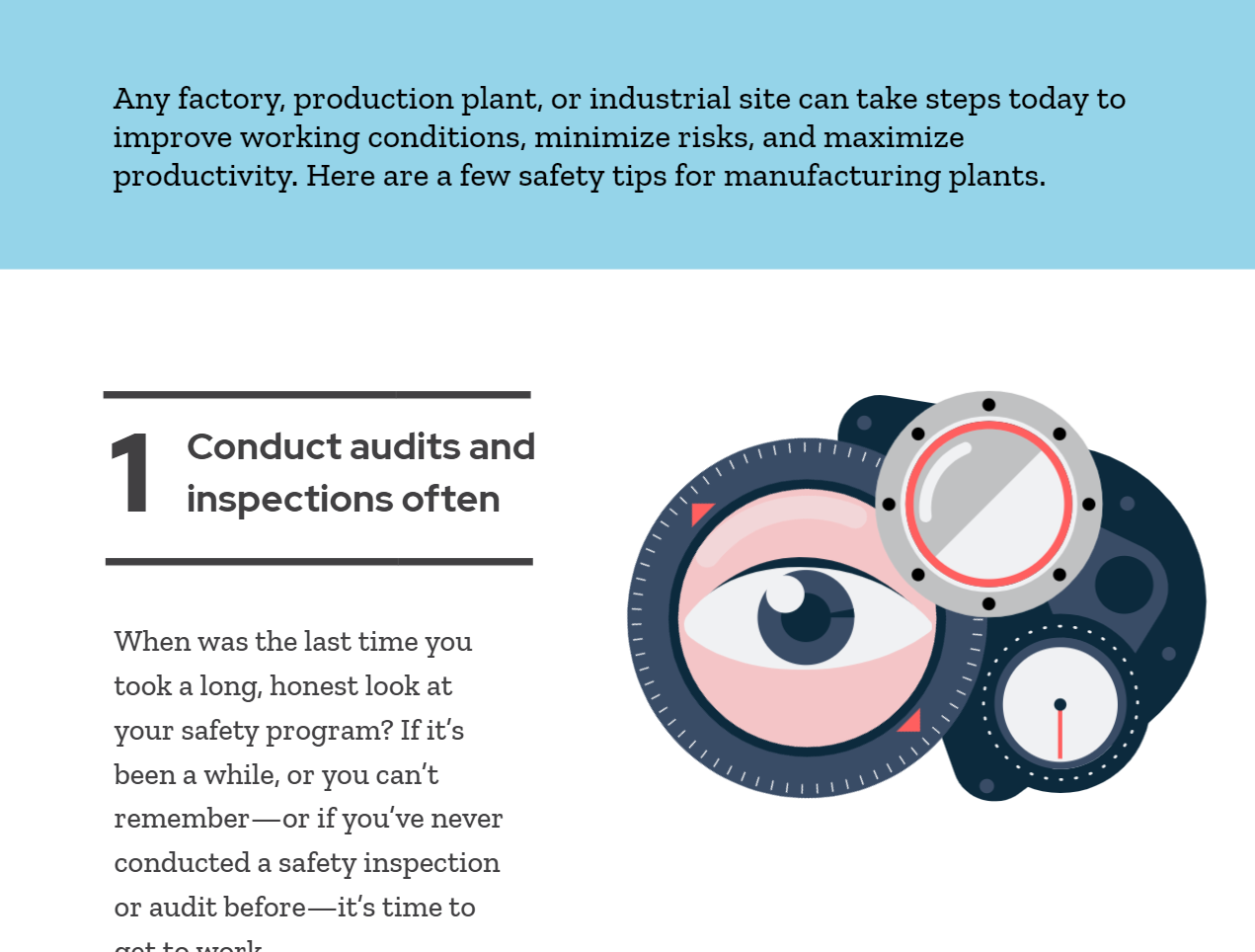5 Ways to Improve Your Manufacturing Safety Program
Any factory, production plant, or industrial site can take steps today to improve working conditions, minimize risks, and maximize productivity. Here are a few safety tips for manufacturers.
1. Conduct manufacturing safety audits and inspections often.
When was the last time you took a long, honest look at your safety program? If it’s been a while, or you can’t remember—or if you’ve never conducted a safety inspection or audit before—it’s time to get to work. By evaluating your facilities, people, and processes, you’ll make your workplace a whole lot safer and more efficient.
Learn how to do safety audits and inspections the right way.
2. Make manufacturing safety a habit.
An exceptional safety record doesn’t happen by accident. In almost all cases, it’s the result of strategic planning, a commitment to safety, and the right habits—a combination of actions and attitudes adopted by people up, down, and across the organization. Wherever there are few or no incidents, there’s a strong safety culture based on the individual behaviors of workers, managers, and executives.
Learn the habits of highly effective safety cultures.
3. Invest in better manufacturing safety training.
How do you deliver training that covers everything your employees need to know, meets various regulatory requirements, maximizes learner retention, and ensures compliance? And how do you do all that without spending a fortune? It’s all about focusing on the learner and using interactive, multimedia tools rather than dry lectures and 1980s-era videotapes.
These are the 4 rules at the foundation of KPA’s award-winning training program:
- know your audience
- use real-world examples
- assess prior knowledge
- promote behavioral change through repetition
Learn how to incorporate these fundamentals into your training.
4. Ensure leadership buys into manufacturing safety.
Poor-performing organizations—the ones with higher-than-average injury rates and safety violations—tend to have low levels of executive support for their safety programs. It’s not that executives at these organizations don’t care about safety. Frequently, the program gets neglected because there are other, more pressing and tangible costs that come first.
And it’s not always just about the money. Even if you have a huge budget for safety, you have multiple moving pieces to track and coordinate—individuals, software, training, and so forth. If there’s no commitment from executive management to acknowledge and support those efforts, it’s exceedingly difficult for the organization to make the jump from poor performer to high performer.
To turn their organizations around, safety professionals need to have a seat at the table. And to gain that seat, they need to be able to speak the language of the rest of the people sitting at the table.
Learn the value of executive buy-in and how to “sell” your safety program to leadership.
5. Simplify manufacturing safety program management with the leading all-in-one software solution.
Manufacturing companies throughout the United States rely on KPA’s safety and compliance solutions to minimize risk and maximize productivity.
Shift your attention away from manual processes and focus instead on creating and maintaining a culture of safety using KPA EHS, our all-in-one software solution for manufacturers. You’ll spend less time on paperwork, spreadsheets, and reporting, and more time in the field with your team—conducting inspections and audits, holding safety meetings, and training employees.
It’s all backed by the manufacturing industry’s #1 library of safety training courses, along with on-demand consulting services, available on-site and online.
Improve your manufacturing safety program—and save money—with KPA. Request a demo.

